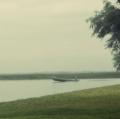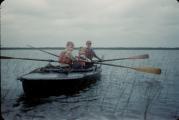First Boats
There were always a lot of boats around the cottage;
not surprising, since the only way to get there
was by boat.
 My grand-father
had a 16', round-bottomed
sedan-cruiser, with a little motor, fitted with a
HUGE flywheel; the "Teal". A fisherman's dream: at
300 rpm, it would troll slowly enough that even a
winter-sluggish Pickerel could catch the lure.
(For some reason, Flatters have always called the
Walleye a Pickerel; I have never run into this
anywhere else. See "sni",
elsewhere.)
My grand-father
had a 16', round-bottomed
sedan-cruiser, with a little motor, fitted with a
HUGE flywheel; the "Teal". A fisherman's dream: at
300 rpm, it would troll slowly enough that even a
winter-sluggish Pickerel could catch the lure.
(For some reason, Flatters have always called the
Walleye a Pickerel; I have never run into this
anywhere else. See "sni",
elsewhere.)
 In addition to the Teal, there was the "putt-putt":
an 18' Thompson lapstrake rowboat with an
absurdly narrow 4' beam. With the 4.2 horse Evinrude
it would barely make hull-speed. Somehow, these two
slow boats carried all the people, supplies, provisions,
and equipment each summer back and forth to the
mainland 4 miles away. Neither boat could make it
in much less than an hour. The boats are long gone,
but I still have the old Evinrude and it still runs.
In addition to the Teal, there was the "putt-putt":
an 18' Thompson lapstrake rowboat with an
absurdly narrow 4' beam. With the 4.2 horse Evinrude
it would barely make hull-speed. Somehow, these two
slow boats carried all the people, supplies, provisions,
and equipment each summer back and forth to the
mainland 4 miles away. Neither boat could make it
in much less than an hour. The boats are long gone,
but I still have the old Evinrude and it still runs.
Then there were the duckboats. Imagine a pumpkin-seed,
enlarged and stretched to 15 or 18 feet long, 4 feet wide,
and 1 foot thick. Now flatten the bottom and cut an
oblong cockpit out of the top and you have a duckboat.
Painted gray, these low boats were invisible against
the open gray waters of the autumn lake.
 When fitted with oars, a 10' punt-paddle and a liftable
canvas sprayrail, you had a boat that could go
almost anywhere. The pointed bow and stern let it slip
through reedy marshes where there was under a foot
of water, yet the oars and sprayrail made
it suitable for going into the open lake in moderate
weather. In the fall, these were my grand-father's;
but in the summer they were our vessels of adventure
and exploration.
When fitted with oars, a 10' punt-paddle and a liftable
canvas sprayrail, you had a boat that could go
almost anywhere. The pointed bow and stern let it slip
through reedy marshes where there was under a foot
of water, yet the oars and sprayrail made
it suitable for going into the open lake in moderate
weather. In the fall, these were my grand-father's;
but in the summer they were our vessels of adventure
and exploration.
As I recall, there were: The Sneakboat (may have been a Fox);
Pederson's Boat; The Layout Boat (this boat rode semi-submerged);
and The Marshboat. (These were our family names for them.)
The duckboats are gone, too; all but one: Pederson's
Boat (after a friend of my Grand-father's) is still
around. Unfortunately, it has been covered with a
layer of fiberglass to stop the leaks. All those beautiful
foot-wide clear pine boards -- soon they'll be gone too,
with the water trapped in them all the time. One of us
(George) builds wooden boats for relaxation. He hopes
to take a set of measurements before the final disintegration.
(The measurements were taken by George and I in the
Fall of 1998. Maybe we can make a stitch-n-glue version
out of marine plywood. It should be lighter, and about
as strong. More news as it develops.)
My uncles,
Harold and Ben, each had boats; and as we
grew older, there were an increasing variety of
outboard-powered boats of all descriptions. (pages
yet to be written)
My home page
Created: Wed, Mar 15, 1995, 06:55 PM
Modified: 4/21/01 2:19:28 PM
By: Peter W. Meek
Net-sig: --Pete <pwmeek@comcast.net>
pwmeek@comcast.net
 My grand-father
had a 16', round-bottomed
sedan-cruiser, with a little motor, fitted with a
HUGE flywheel; the "Teal". A fisherman's dream: at
300 rpm, it would troll slowly enough that even a
winter-sluggish Pickerel could catch the lure.
(For some reason, Flatters have always called the
Walleye a Pickerel; I have never run into this
anywhere else. See "sni",
elsewhere.)
My grand-father
had a 16', round-bottomed
sedan-cruiser, with a little motor, fitted with a
HUGE flywheel; the "Teal". A fisherman's dream: at
300 rpm, it would troll slowly enough that even a
winter-sluggish Pickerel could catch the lure.
(For some reason, Flatters have always called the
Walleye a Pickerel; I have never run into this
anywhere else. See "sni",
elsewhere.)

